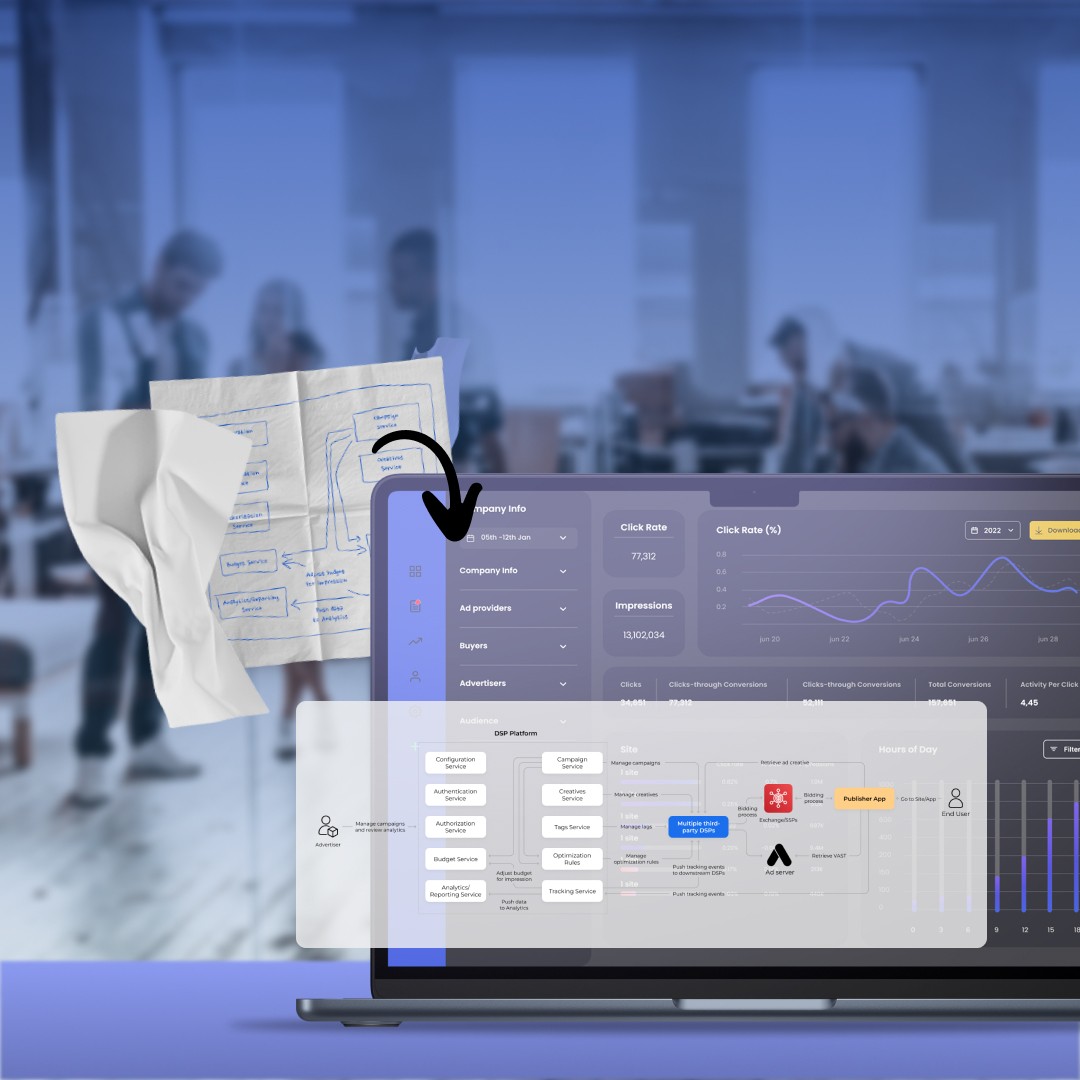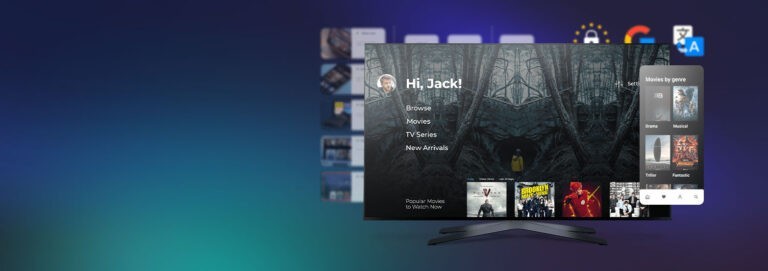Just a couple of decades ago, people could only watch TV in their households. The whole family was sitting in front of the TVs and watching similar films or TV shows. With the discovery of the internet, people are now privileged to enjoy their favorite content alone and from anywhere. Video content creators grabbed this opportunity, which gave birth to OTT platforms and numerous OTT services.
Why is the market so promising? Who can still win by investing in OTT development? And how to build an OTT platform? All these questions are answered in our blog post.
OTT app development market: current state and trends
The OTT market looks lucrative, and there are several reasons proving this fact.
Why is it still worth investing? People are no longer limited to watching films in front of their TVs, they now can watch them from anywhere with the internet. Without any doubt, the industry is on the rise with new monetization opportunities like adopting FAST services and the variety of big screens and alternative devices used to watch video.
That’s why video business owners should consider creating OTT platforms that will help them:
- Reach more viewers
- Improve their video streaming services
- Increase the revenue
Market players leveraging OTT platform development
Who are those online video business owners that will benefit from OTT platform development? There are two big players for whom this may be helpful.
- Online video software vendors. By delivering all kinds of video software, software infrastructure providers help the market players tackle such challenges as effective content distribution, intelligent content recommendations, multi-screen coverage, and much more. How does OTT development help them? To make their white-label solutions more competitive and oriented to client needs, video software providers may need to adjust their frontend components by adding more advanced functionality, optimizing the platform performance, and adapting its functioning to multiple platforms.
- Content owners and aggregators. These market players are responsible for delivering video content to end viewers through online video streaming platforms. How does OTT development help them? To expand their presence on multiple screens, content owners and aggregators would need to create an outstanding viewing experience on Smart TVs, web platforms, and mobile devices.
How we can help
Whether you build video software or aggregate video content, we can be helpful. Let’s discuss your needs!

Popular OTT platform types: from TV channels to audio content
OTT content distribution platforms usually refer to high-quality video content and typically include:
- OTT TV broadcasting platforms like Apple TV, Android TV, Google TV, Amazon Fire Stick.
- OTT video platforms like Netflix, Amazon Prime.
- OTT video content offering a broad range of entertainment, including traveling, education, and music.
So, do you feel like building one of the OTT video platforms? Keep on reading to learn how you can do it.
How to build an OTT video streaming app?
1. Define your OTT app development needs
Whether you are a video content aggregator or an OTT app provider, there are two OTT app development options available: custom development from scratch and a white-label OTT platform. Both development models are viable for businesses of any size, but you should consider your goals. Do you produce your own video content but don’t have an OTT platform to distribute it to a target audience? Does total control over the app’s performance, content and maintenance matter to you? Or let’s imagine you’ve already developed an online video solution, but you lack OTT app developers to satisfy specific customer needs. So, would you recognize yourself in any of the scenarios? Here are the two ways you can deal with OTT development:
- Customize a white-label OTT solution.
It’s considered to be a cost-effective and less time-consuming way for both video content aggregators and software providers to launch OTT services. Still, if you strive to gain more responsibility over UI/UX or app performance, you’d better opt for from-zero development. - Develop a tailored OTT platform from scratch. Though this option gives you a free hand in building functionality, creating personalized user experiences, and fixing technical issues on site, it’s costly enough and may take longer to release to the market.
Now, when you’ve understood your high-level goals, you might wonder how much it may cost you.
2. Set up your project budget
Again, the overall costs depend on your OTT development project goals. Among the top three needs requested in the OTT development market are:
- Developing an OTT app builder to deliver full-fledged streaming services.
- Creating a tailored front-end solution to ensure user-friendly in-app functionality.
- Expanding an online video streaming experience across multiple devices.
So, “How much would this cost?”, you may ask. There is no fixed budget for OTT platform development, because it all depends on the features, platforms, and other factors. The prices typically start from:
- $140K to $420K for WebOS and Tizen
- $325K for the integration of distribution, customers, and business rules
- $225K for content management
- $375K for asset management, media analysis, metadata enrichment, and editing features
- $150K for ingest and storage incorporation
When budgeting your project, consider the costs below:
- Platform size and desired capabilities
- Tech stack and the platforms you are planning to cover
- Development model (in-house or outsource)
- Time-to-market goals
The next sections will help you set up the budget lines.
How we can help
Are you about to start your OTT project? We’ll estimate your costs!

3. Define UX/UI capabilities for your OTT platform
One of the OTT platform development goals is to streamline user interactions on video streaming devices and engage viewers with the distributed content. How can you ensure this? UI/UX best practices should be at the core of your OTT software development strategy. While defining the functionality set of your OTT solution, don’t forget about these four main principles:
- Simplify user experience as much as possible by eliminating tricky functionality and applying common user behavior patterns.
- Ensure a user can get your content in three clicks, no more. Extra navigation buttons, smart suggestions, predefined navigation will serve this need.
- Get viewers equipped with additional powers, like using companion devices or voice search.
- Make users search for content faster with smart suggestions powered by the analysis of viewers’ behavior, mood, and preferences.
Finally, here’s the list of must-have features that can be complemented by extra perks:
- Watchlist to let users add “watch later” content.
- Search functionality such as voice search, text search, and filtering options.
- User profiles for personal management: preferred payment options, content to watch.
- Social features to boost user engagement with the OTT app and its content.
- Payment integration to enable one of the chosen monetization models.
4. Ensure your video content is managed carefully
Content is the main pillar of an OTT video platform, and its management is another top priority. However, ensuring thorough management of media assets may be tricky. Here are a few tips for you to keep in mind when creating a media asset management system for your OTT solution.
- Make it scale as you grow with a flexible cloud-based infrastructure.
- Ensure seamless integrations by introducing microservices architecture and orchestration middleware or across-all-systems data management.
- Create user-friendly workflows using consistent UI, handy navigation, and clear visualizations.
- Turn complexities into efficiency.
How we can help
We know how to make your OTT app content management seamless and flexible.

5. Choose an appropriate technology stack
Would you build your OTT development strategy based on a multi-screen viewing experience? If so, then take into account the guidelines below to understand the users of which platforms and devices you are going to target and what technological solutions are available for them.
- Apps for Smart TV devices. To catch the attention of viewers on big screen devices like Samsung, LG, Sony, or Panasonic, you need to establish your presence there with Smart TV apps. Why? While 90% of US households own a TV, 50% of them use Smart TVs.
- Custom Android TV launchers for STBs. Would taking control over viewing experiences from the first click and screen be your next step in engaging viewers with your video content? How wise it is! Because the other 50% of US TV viewers may still make use of set-top boxes.
- Mobile streaming apps. Going mobile to let viewers watch your video content wherever they are? With 88% of mobile time spent on apps, it’s an excellent chance to gain new users or retain the current ones by allowing them to continue watching, no matter where they are located.
How we can help
We deliver front-end video solutions tailored for any OS, platform, and device.

6. Select a business model to monetize your OTT service
When entering the OTT market, it’s crucial to choose the OTT business model corresponding to your needs. Among the possible options could be:
- Ad-based video on demand (AVOD) allowing viewers to watch content for free, but it would include video commercials, banners, or fully sponsored content.
- Subscription video on demand (SVOD) giving users the content free of ads through a subscription.
- Transactional video on demand (TVOD), or pay-per-view or pay-per-download, that sells the content for a set price.
Still, if you want to gain more flexibility, consider a hybrid OTT revenue model. This will help you adjust your OTT services to various demands. For example, you can provide some video content for free, while distributing premium content within a subscription-based package.
Further reading
4 business models to drive more revenue from your OTT service
Learn more about each monetization strategy and choose the one that will bring you bigger profits.

7. Choose the right technology partner for your OTT platform development project
Whether you opt for video streaming app development from scratch or a white-label solution offered by an online video software vendor, you need an OTT development team to deliver your project.
How Oxagile can help you
Delivering OTT development services to content owners, aggregators, and software vendors, we can help you face any challenge by:
- Streamlining user navigation within an OTT app through our UX/UI best practices.
- Ensuring fault-free OTT app performance, optimizing them for different OTT platforms, OSs, devices, and their versions.
- Offering cross-platform OTT app development, which may be a cost-effective alternative to native video streaming app development.
- Guiding through native or third-party video players and turning their limitations into interactive custom functionality.
- Building targeted advertising solutions to implement FAST, AVOD, or other OTT monetization strategies.
- Creating outstanding experience management functionality to manage your OTT service offering without OTT app developers.
In a nutshell
The OTT market is growing faster than ever before, so it’s a good investment point, especially for video content aggregators and video software providers. With the two options available, custom OTT app development and a white-label solution, the market players may rely on the budget they can afford to reach the target viewer.




























